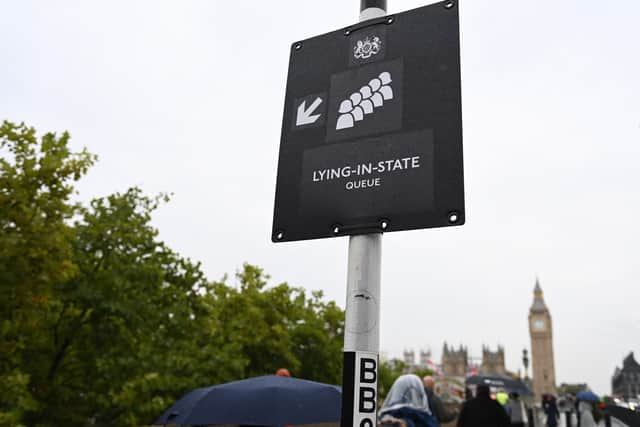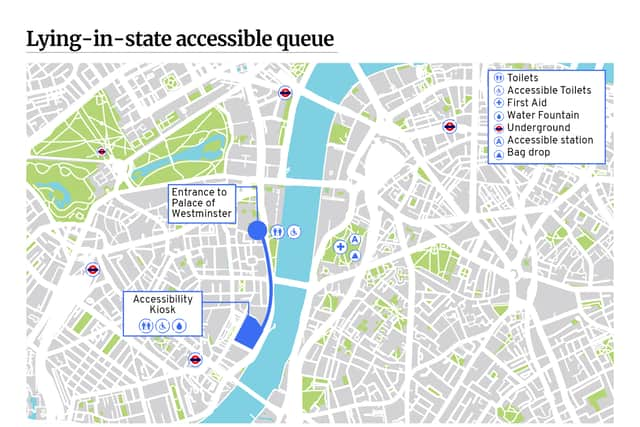Queen’s lying in state: how to join accessible queuing scheme, how long is the queue - what is the route?
and live on Freeview channel 276
Disabled people will be able to join a shorter special access queue to see the Queen lying in state in Westminster Hall.
The public will be able to pay their respects to the late monarch from 5pm 14 September until 6.30am on Monday 19 September, the day of the Queen’s funeral.
Advertisement
Hide AdAdvertisement
Hide AdDisabled people will be able to join a separate and shorter special access route, avoiding the 10-mile queue from Southwark Park along the South Bank to Westminster.
The accessible queuing scheme is available for those with a disability or long-term condition who cannot queue for an extended period of time.
Up to 750,000 mourners are expected to pay their respects, and queues have already begun to snake along the streets of London.
Here is everything you need to know about how to join the accessible queuing scheme, what the route is for the queue and the timings of the coming days.


How can I join the accessible queuing scheme?
Advertisement
Hide AdAdvertisement
Hide AdThere is an accessible queuing scheme available for those with a disability or long-term condition who cannot queue for an extended period of time.
If you require this queue, you can be accompanied by one carer or companion.
Government guidance states that there will be limited capacity for the accessible queue each day, so entrance is not guaranteed.
There will still be some waiting time for people in the accessible queue.


Advertisement
Hide AdAdvertisement
Hide AdIf you need to use the accessible queuing scheme you must go to the accessible kiosk at Tate Britain on Millbank and you will be given a timed entry slot for the Lying-in-State.
When it is time for your visit, you can join the accessible queue.
You can join the accessible queue at Victoria Tower Gardens, which is approximately half a mile from the accessible kiosk.
There is a direct, step-free route from Tate Britain to Victoria Tower Gardens along Millbank.
Advertisement
Hide AdAdvertisement
Hide AdThere will be stewards along this route to direct you and guide you to the accessible queue.
You can find information on the accessible queue on the Government’s website.


What is the route for the accessible queue?
The accessible route will begin at Tate Britain where timed entry slots will be issued for a queue heading along Millbank to the Palace of Westminster.
Guide dogs, hearing dogs and other official assistance dogs will be permitted in Westminster Hall.
Advertisement
Hide AdAdvertisement
Hide AdBritish Sign Language interpreters will also be available to people joining the queue.
More than 1,000 dedicated volunteers, stewards and Metropolitan Police officers will be on hand to assist members of the public wanting to pay their respects and keep them safe.
What are the timings of when the Queen’s coffin will be moved?
At 2.22pm on Wednesday (14 September), Queen Elizabeth’s coffin will be taken in procession by gun carriage from Buckingham Palace to the Palace of Westminster.
The King, Prince William and Harry, as well as other royals and staff from the royal household will walk behind.
Advertisement
Hide AdAdvertisement
Hide AdAt 3pm, the casket will arrive at the Palace of Westminster where the Archbishop of Canterbury will conduct a short service.
The Queen’s lying in state will then begin in Westminster Hall from 5pm.
Her Majesty’s closed coffin will rest on a raised platform and will be draped in the Royal Standard with the Imperial State Crown and a wreath of flowers placed on.
Comment Guidelines
National World encourages reader discussion on our stories. User feedback, insights and back-and-forth exchanges add a rich layer of context to reporting. Please review our Community Guidelines before commenting.
